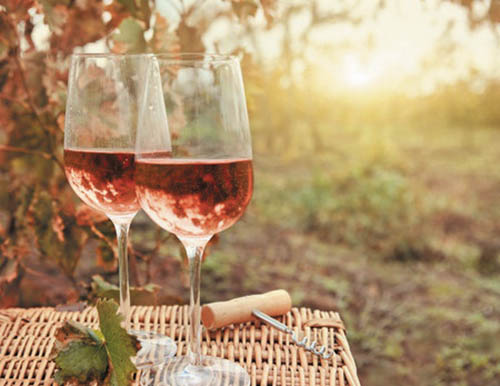


According to a recent study, Rosé wine sales are growing at least 10 times faster than the growth of overall table-wine sales in the United States. In fact, “US retail sales of premium imported Rosé wines (those priced at or above $12 a bottle) grew by 41 percent on volume and 53 percent on value in recent years,” Nielsen reported in January. “This is compared to growth rates of 1.0 percent on volume and 3.3 percent on value for the total table-wine market.”
So why is Rosé taking the wine industry by storm?
Rosé is wonderfully refreshing, pairs beautifully with foods and because there are so many different varietal blends to choose from, there’s a Rosé wine for every taste. And, it’s surprisingly multi-dimensional. In fact, whatever flavor profile you enjoy in your red wines, you’ll also enjoy it in a Rosé, only it will be lighter and more refreshing—wonderful year round and just about perfect for warmer weather.
Rosé wine is actually made from red grapes (usually a blend of a few different varietals) that are lightly crushed and then left to macerate with their red skins. The longer the skins sit in the wine, the darker pink the finished Rosé will be and the more it will develop the tannic characteristics of red wine. And, most Rosé wines are blends that can include many different varietals such as Cinsault, Carignan, Grenache, Mourvedre, Pinot Noir, Sangiovese, Syrah and others. They can range in taste from extra dry to crisp and fruity, which gives Rosé one of most versatile, expansive flavor profiles of any wine varietal.
Rosé is also one of the most affordable wines around. Because they are relatively inexpensive to make and don’t require aging, you’ll be hard-pressed to find a greater value than Rosé wine. In short, Rosé wines are as kind to your wallet as they are to your tastebuds.
“Rosé sales are booming,” said Scott Maybaum, President, Wine Country Management. “Today, we’re seeing Rosé varietals from some of the best vineyards and from virtually every wine region.”
In the kosher wine market, there’s an impressive assortment of Rosé wines to try, from vineyards around the world, and they’re every bit as good, as complex and as flavorful as the quality kosher wines you already love to drink. It’s the next big thing in wine and you need to be a part of it.
Here are a few of our favorite kosher Rosés:
Flam Rosé—Israel
100% Cabernet Franc – 12.5% alcohol content
What the Winemaker Says:
The grapes are cold macerated on the skins for several hours to extract optimal Rosé color, and then cold fermented in stainless steel tanks for 3 weeks to enhance the flowery and fresh red fruit aromas.
Why We Love It:
Hesitant to try Rosés? This is the one to start with. From the first sip, you’ll be hooked. Dry, refreshing and crisp, it pairs well with just about any food, with enough confidence for sipping poolside on its own.
Herzog Selection Les Lauriers des Rothschild Rosé—France
20% Cabernet Franc/10% Cabernet Sauvignon/70% Merlot – 13.5% alcohol content
What the Winemaker Says:
This blend varietal wine, from the appellation of St.-Emillion in France, is aged for 14 months, 60% in second-fill French oak barrels, and rests in tanks. It pairs superbly with meats like veal, duck and lamb, or French cheese.
Why We Love It:
Immediately you’ll notice its pale pink hue. Lighter in color, but deeper in flavor. Very French in style, so definitely more of a food-pairing wine than some of the other Rosés.
Capcanes Peraj Petita Rosat—Spain
60% Garnacha/20% Tempranillo/20% Merlot – 13% alcohol content
What the Winemaker Says:
Aged 4 months in stainless steel tanks before bottling, this Rosé is bright and very aromatic, with red fruit flavors of strawberry. Interesting acidity and sweetness in the mouth and a long fruity finish.
Why We Love It:
Light, easy drinking blend with a crisp finish. Pair it with pizza, chicken, smoked salmon, pasta with tomato sauce. Refreshing and perfect for summer.
Goose Bay Blanc de Pinot—New Zealand
100% Pinot Noir – 13% alcohol content
What the Winemaker Says:
A light yet flavorful composition with a dry finish. Blush colored with lingering strawberry and an earthy minerality. Enjoyed with seafood, chicken curry and sushi.
Why We Love It:
If you like your Rosés dry, this is one to try. Definitely needs to sit for a bit after opening, but worth the wait. You’ll smell—and taste—the strawberries right away and enjoy the slight arugula notes on the finish.
Psagot Rosé—Israel
Red blend – 13% alcohol content
What the Winemaker Says:
A blend of red grape varietals. The grapes are harvested from vineyards located in the Northern Jerusalem Mountains at a height of 700 meters. With a very clean and fresh flavor, this wine will pair smoothly with Mediterranean cuisine.
Why We Love It:
Somewhere between dry and sweet. The more time in the glass, the more the intense fruit flavors opened up. We tried it with a light pasta dinner—fantastico!
Terra Di Seta Meshi Toscana Rosé—Italy
Sangiovese – 14.5% alcohol content
What the Winemaker Says:
Grown in a completely kosher winery in the Tuscany region. Intense flavor of small red berry fruits, well balanced with good freshness and mineral taste.
Why We Love It:
A mouthful of fruit in every sip. Dry, crisp, refreshing. Perfect for beach or poolside, great with your favorite grilled meats or seafood.
Want to see what all the Rosé buzz is about for yourself? Visit Wine Country in Bergenfield store, 89 New Bridge Road, and pick up a bottle of kosher Rosé wine. We’re guessing it will be the start of a beautiful wine relationship!
By Kim Renta, Wine Country Stores
Kim Renta is a wine enthusiast, blogger and social media coordinator for Wine Country Stores.










